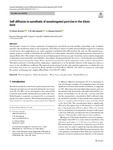Mostrar o rexistro simple do ítem
Self-Diffusion in Nanofluids of Nonelongated Particles in the Dilute Limit
| dc.contributor.author | Fariñas Alvariño, Pablo | |
| dc.contributor.author | Sáiz Jabardo, José M. | |
| dc.contributor.author | Cabezas-Gómez, Luben | |
| dc.date.accessioned | 2021-10-27T14:56:44Z | |
| dc.date.available | 2021-10-27T14:56:44Z | |
| dc.date.issued | 2021-07 | |
| dc.identifier.citation | Fariñas Alvariño, P., Sáiz Jabardo, J.M. & Cabezas-Gómez, L. Self-diffusion in nanofluids of nonelongated particles in the dilute limit. J Braz. Soc. Mech. Sci. Eng. 43, 392 (2021). https://doi.org/10.1007/s40430-021-03101-6 | |
| dc.identifier.issn | 1678-5878 | |
| dc.identifier.uri | http://hdl.handle.net/2183/28745 | |
| dc.description | Financiado para publicación en acceso aberto: Universidade da Coruña/CISUG | |
| dc.description.abstract | [Abstract] The dynamic features of a dilute suspension of nanoparticles (nanofuid) are fully modifed depending on the dominant particles slip mechanism acting in the suspension. Self-difusion efects in highly sheared diluted suspensions (entrance conditions and microapplications) can lead to a particles distribution fully diferent from the bulk one. The reported investigation proposes a model to determine the self-difusion of three-planes symmetric nonelongated particles inmersed in a sheared Stokes fow. The model is based on the real displacements between any pair of particles and an statistical approach to determine contact kinematic irreversibilities. According to the proposed model, the source of hydrodynamic irreversibility is closely related to the particles shape. This is clearly demonstrated through the application of the model to cubic particles. The main conclusion is that the particles shape plays a signifcant role in the dynamic behavior of the suspension and, as a result, in the self-difusion coefcient. The reported results arising from the cubic particles trajectories in a Stokes fow are reasonably close to the ones reported by Brady and Morris (J Fluid Mech, 348:103–139, 1997) for suspensions under high Pe number, and Zarraga and Leighton (Phys Fluids 13(3):565-577, 2001) | es_ES |
| dc.description.sponsorship | The authors gratefully acknowledge the support given to the investigation reported herein by the Galician High Performance Computing Center (CESGA) and the Ministry of Economy and Competitiveness, Spain, through the Grant No. ENE2012-38326-C02-01. Open Access funding provided thanks to the CRUE-CSIC agreement with Springer Nature | es_ES |
| dc.language.iso | eng | es_ES |
| dc.publisher | Springer | es_ES |
| dc.relation | info:eu-repo/grantAgreement/MINECO//ENE2012-38326-C02-01/ES/ESTUDIO DEL EFECTO DEL ACABADO DE LA SUPERFICIE CALIENTE EN LA EBULLICION NUCLEADA/ | |
| dc.relation.uri | https://doi.org/10.1007/s40430-021-03101-6 | es_ES |
| dc.rights | Atribución 4.0 Internacional | es_ES |
| dc.rights.uri | http://creativecommons.org/licenses/by/4.0/ | * |
| dc.subject | Particle migration | |
| dc.subject | Stokesian dynamics | |
| dc.subject | Micro-/nanoscale phenomena | |
| dc.subject | Particle/fluid flows | |
| dc.title | Self-Diffusion in Nanofluids of Nonelongated Particles in the Dilute Limit | es_ES |
| dc.type | info:eu-repo/semantics/article | es_ES |
| dc.rights.access | info:eu-repo/semantics/openAccess | es_ES |
| UDC.journalTitle | Journal of the Brazilian Society of Mechanical Sciences and Engineering | es_ES |
| UDC.volume | 43 | es_ES |
| UDC.issue | 8 | es_ES |
| UDC.startPage | 392 | |
| dc.identifier.doi | 10.1007/s40430-021-03101-6 |
Ficheiros no ítem
Este ítem aparece na(s) seguinte(s) colección(s)
-
GI-SISTER - Artigos [35]






